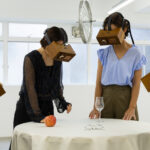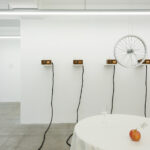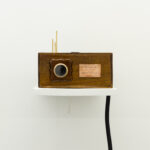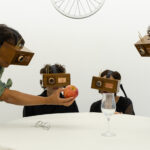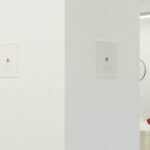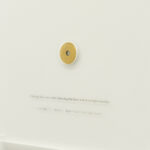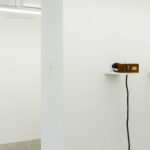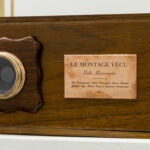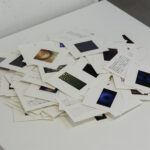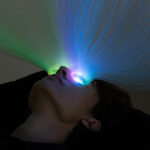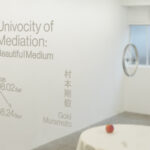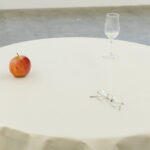Exhibition
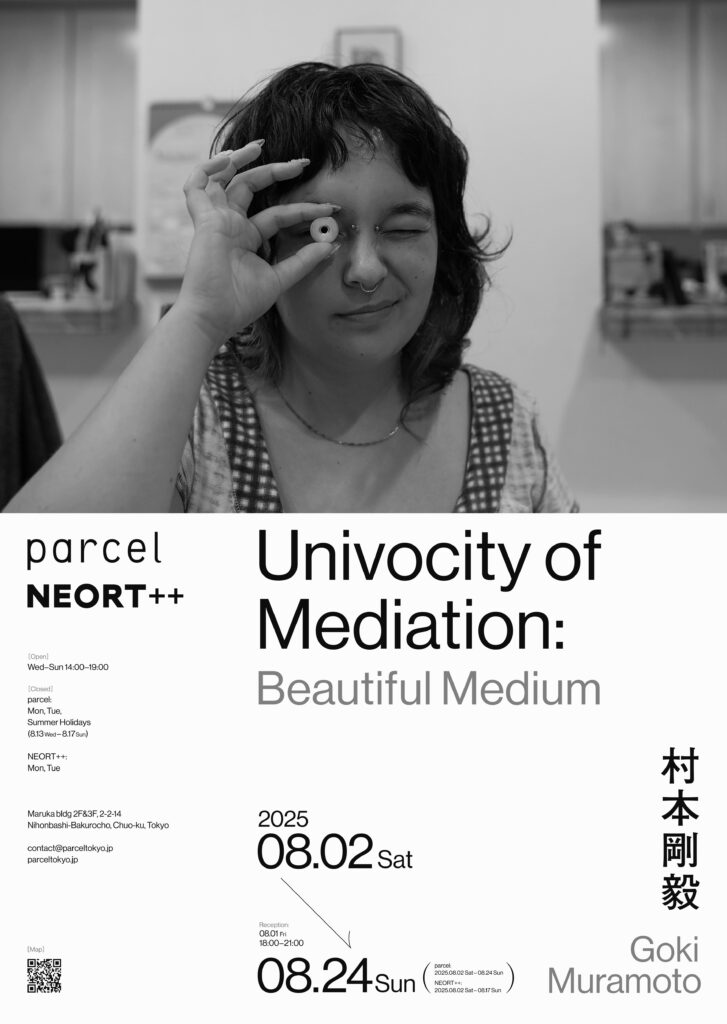
Past
2025
08.02Sat
2025
08.24Sun.
NEORT++ / parcel
Opening reception on August 1st, Fri. 18:00-21:00
Open on Wed - Sun
14:00 - 19:00
NEORT++: Closed on Mon, Tue
parcel: Closed on Mon, Tue, National Holidays
Summer closure: August 13th (Wed) - 17th (Sun)
Univocity of Mediation:
Beautiful Medium
村本 剛毅|Goki Muramoto
details - JP
この度、parcelとNEORT++は初めての共同展として、村本剛毅による個展「Univocity of Mediation: Beautiful Medium」を開催いたします。東京を拠点に活動する村本剛毅は、アーティストとして、知覚、コミュニケーション、移動を含む「媒介」を、独自の「媒体(メディア)」を発明/彫刻するという行為によって探求しています。
本展では、複数作品を同時に公開する村本の初個展として、代表的な三つのシリーズ《Imagraph》《Lived Montage》《Training Wheels》を展開します。一連の作品は村本が実践する《媒体芸術 / Medium-Art》そのものを提起します。
もし「メディアはメッセージである」ならば、
そのメッセージを詩として書くことができるのではないか?
あらゆるものは何かを介して移動する。
(介されるものの爆音の中で、)介するものが介することによって介する時だけに鳴らす別の音に聞き耳をたて、マーシャル・マクルーハンはメディアをメッセージと呼んだ。いつからか私の体はこの音でも震えていて、私はその音が自分によっても鳴らせるものであることに気づいた。
私の仕事は、美しいメディアを作ることである。
Meine Aufgabe ist es, ein schönes Medium zu schaffen.
この展示は、とりわけ視覚をめぐる3つのメディア — 瞼を通して閉じた眼にビデオ見せる投影機Imagraph, 同じものを見た他者と視界を映画的に共有する眼鏡 Lived Montage,指定された一文の信念を強制されながら景色を見るためのリング Training wheels — を紹介するとともに、この仕事、そして媒体芸術/Medium-Art を提起する。
村本剛毅
《Imagraph》は、閉じた眼に対してまぶた越しに映像を投影する光学装置です。鑑賞者は目を閉じてベッドに横たわります。あらかじめ皮膚の血色を補正し青みがかった色調に変換されたビデオは、目を瞑る参加者の視界に意図された色彩とその配置と運動を伝達し、蓋は同時にまさにそれが拒もうとするものの媒体となります。閉眼という特権的な姿勢のもとで、映像の光は鑑賞者の無意識によるイメージとテクスチャーを共有して融解し、鑑賞者はどこまでが提示された映像でどこまでがそうでないのかを見失います。展示会場では、Imagraphを鑑賞するスペースに加えて、このメディアを理解するためにキュレーションされた資料・小品群《after-study for Imagraph》ーそれは作品を生み出すための習作(study)ではなく、作品を理解するために事後的に行われるstudyですーを展開します。イメージ(image)を描く(graph)装置と名付けられたこのメディアは、イメージのはじまりを連想させる奇妙な視覚体験と共に、見るもの/見せるものとして我々がもっている自由を問いただします。
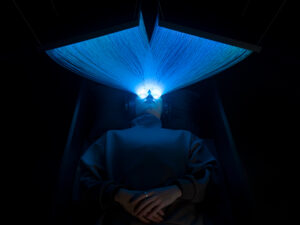
Goki Muramoto Imagraph (series), 2020-, mixed media, Photo by Kai Fukubayashi
《Lived Montage》は、知覚の形態として映画的モンタージュを再構築するためのゴーグル型の装置です。装置にはカメラと両眼ディスプレイが組み込まれており、参加者の目には、全員の元の視界をリアルタイムに編集した映画的な映像が投影されます。そして参加者はそれを通して空間を観察・行動し、やがてこの新たな知覚の形態に慣れていきます。本展示では、「同じものを見た全員の視界が心拍のタイミングで切り替わる」というバージョンが実演されます。動的に変容する集合的な身体と抽象的な空間認識を形成される中、「何が、何を、見ているのか」という視覚の構造に対する根源的な問いが提示されます。
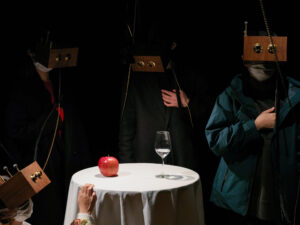
Goki Muramoto, Lived Montage, 2021-, mixed media, Photo by Kai Fukubayashi
《Training Wheels》は、穴の空いた真鍮の円盤とそれに一対一で対応するインストラクションによって構成された、簡素ながら詩的な作品シリーズです。手作業で片面が研磨された円盤には「すべての色はそれ自身が発光していると信じて、(何かを)見なさい」「すべてのものはすべてのものに触れたことがあると信じて、(何かを)見なさい」といったインストラクションが添えられており、鑑賞者は円盤を通して周囲の景色をみる間それに従わなければなりません。「ー(想像)しなさい」というインストラクションの形式をメディアの水準において行うこのシリーズは、媒体そのものを芸術作品とする村本の制作態度を簡潔に示すものでありながら、見るものの能動的な努力によって諸関係の鮮烈な変容を引き起こします。
本展タイトル「Univocity of Mediation: Beautiful Medium」は、メディアをメディアと呼ばせているメディエイション(媒介)が、ただ一つの同じ意味で語られるということを示しています。ここでは、人が神について語ることの可能性をめぐってスコトゥスが提起し、後にドゥルーズが差異そのものが肯定される平面として再構成した「Univocity of Being|存在の一声性(一義性)」という概念が意識されています。一義的な媒介と多様な媒体(媒介者)の差異のなかに、そして存在と媒介の差異のなかに、村本は自身の「声(voice)」を探ろうと試みています。
マクルーハンの有名なフレーズ「メディアはメッセージである(the medium is the message)」に対し、村本は端的に「このメッセージにおいて詩を書くこと」を自身の最も自然な表現行為として認め、その技術を「媒体芸術/Medium-Art」と呼びます。まさに本展は、この芸術の潜在的な系譜を読み出そうと試みる村本が、自身の作品群/媒体群を通じて、ラディカルな「媒体芸術家/Medium-Artist」像を提示する最初の機会となります。
企画:NEORT++ / parcel
NEORT++ にて展示している作品《Imagraph》を体験いただくには予約が必要です。下記ボタンから日程の予約をお願い致します。 作品の体験なしで自由にギャラリー内をご覧いただくことも可能です。
details - EN
parcel and NEORT++ are pleased to present, Univocity of Mediation: Beautiful Medium, a co-hosted solo exhibition by Tokyo-based artist Goki Muramoto. Goki Muramoto explores the concept of “mediation”—including perception, communication, and movement—through the act of inventing and sculpting his own unique “medium.”
This exhibition marks Muramoto’s first solo show to present multiple works simultaneously, showcasing three of his representative series: Imagraph, Lived Montage, and Training Wheels. Together, these works propose the art that Muramoto refers to as Medium-Art.
If “the medium is the message,” can this be a poem?
Everything moves through something. Listening to another sound—one that what is mediating makes, only by mediating, only while mediating—amidst the loud sound of what is mediated, Marshall McLuhan called the medium the message. Somewhere along the way, my body was also vibrating with this sound, and I realized that it was something I could also make.
My task is to make a beautiful medium.
Meine Aufgabe ist es, ein schönes Medium zu schaffen.
This exhibition introduces three media works that each engage vision in distinct ways— Imagraph, a projector that presents video to closed eyes through the eyelids; Lived Montage, a pair of glasses that cinematically shares the field of vision with another viewer seeing the same thing; and Training Wheels, a ring that compels the viewer to look at the world through the lens of a predetermined belief expressed in a single sentence— and propose Medium-Art itself.
Goki Muramoto
Imagraph is an optical apparatus that projects motion pictures onto closed eyes through the eyelids. The viewer lies down on a bed with their eyes closed. A video—preprocessed to shift the skin tone of the participant toward a bluish tint—is projected so that the intended colors, arrangements, and motions are conveyed to the closed eye. At this moment, the eyelids become the medium for precisely what they are supposed to reject. Under the privileged condition of closed eyes, the projected light melds with unconscious visual imagery and shares its textures, blurring the boundary between what is being shown and what is not. In the exhibition space, in addition to the area where Imagraph can be experienced, a curated set of materials and small works titled after-study for Imagraph will be presented—these are not studies for producing the work, but studies conducted afterward in order to understand the work (as media). Named after an apparatus for writing (in) images, this medium interrogates the freedom we possess about the image, both as sender and receiver, through a strange visual experience that evokes the origin of the image itself.
Lived Montage is a goggle-type device designed to reconstruct cinematic montage as a form of perception. The device is equipped with cameras and binocular displays, and projects a cinematic image—created by editing all participants’ original fields of vision in real time—onto each participant’s eyes. The participants observe and act within the space through this vision, and gradually become accustomed to this new perceptual form. In this exhibition, a version will be demonstrated in which the views of all who have looked at the same thing are switched in sync with their heartbeats. As a dynamically transforming collective body and abstract spatial awareness are formed, a fundamental question is posed about the structure of vision: “What sees what?”
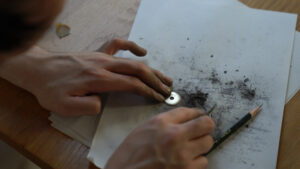
Goki Muramoto, Lived Montage, 2021-, mixed media, Photo by Kai Fukubayashi
Training Wheels is a modest yet evocative series of works composed of perforated brass discs, each paired with a corresponding instruction. The hand-polished discs are accompanied by instructions such as, “See (something), believing that every color is emitted by itself,” or “See (something), believing that everything has touched everything.” While viewing the surrounding scenery through the disc, the viewer is required to follow these instructions. This series, which performs the act of instruction—imagine…—on the level of media itself, embodies most succinctly Muramoto’s artistic stance of treating the medium as the artwork. It invites the viewer to undertake an active effort of seeing, through which existing relationships are dramatically transformed.
The exhibition title Univocity of Mediation: Beautiful Medium refers to the idea that mediation, which renders media as media, is spoken of in the same single sense with regard to everything it addresses. With reference to the concept of the univocity of being, originally posed by John Duns Scotus in the theological discourse concerning the possibility of speaking about God, and later reconstructed by Gilles Deleuze as a plane where difference itself is affirmed, He seeks to explore his artistic language—his “voice”—within the mediological difference between univocal mediation and the various media, and within the difference between being and mediation.
In response to Marshall McLuhan’s famous phrase, “the medium is the message,” Muramoto straightforwardly affirms that “writing this message as a poem” is his most natural form of expression, and he refers to the art of doing so as “Medium-Art.” This exhibition marks the first occasion on which Muramoto, who has been attempting to trace the latent genealogy of this art, presents a radical figure of the “Medium-Artist” through his own body of works and media.
Organized by NEORT++ / parcel
Reservations are required to experience Imagraph, currently on view at NEORT++. Please use the button below to reserve a time slot. You are also welcome to freely browse the gallery without experiencing the work.
Photo credit: Kohei Omachi (W)
展覧会、各作家、作品等に関するお問い合わせはcontact@parceltokyo.jp までお願いいたします。
For further information regarding this exhibitions or the artists, artworks please contact us at contact@parceltokyo.jp
村本 剛毅|Goki Muramoto
アーティスト。1999年、山口生まれ、東京を拠点に活動。
独自の「媒体」を発明・彫刻する実践を通じて、知覚やコミュニケーション、移動を含む「媒介」について探求している。主な作品は、閉じた瞼に映画を投影する光学装置《Imagraph》series、意識する対象を他者と共有するときに視界も共有する眼鏡《Lived Montage》series、単語翻訳の連鎖を地図にした辞書/彫刻《Media of Langue》など。制作と並行して、内容に開かれた媒体そのものを芸術作品とする実践を「メディウムアート/Medium-Art」と名づけ、その理論的背景と系譜をリサーチしている。現在東京大学学際情報学府博士課程に所属。日本学術振興会特別研究員(DC1)。
Artist. Born in Yamaguchi in 1999, Japan. Lives and works in Tokyo.
He explores “mediation,” encompassing perception, communication, and movement through the process of inventing and sculpting their original”mediation.” Major works include Imagraph, a medium that projects video onto closed eyelids; Lived Montage, a pair of glasses that allows us to share our vision when we share the object of our consciousness; and Media of Langue, a dictionary-sculpture that depicts a chain of word translations.He defines ‘Medium-Art’ as treating the medium itself—open to content—as the artwork, and explores its theoretical and genealogical dimensions.His work has been exhibited nationally and internationally.

